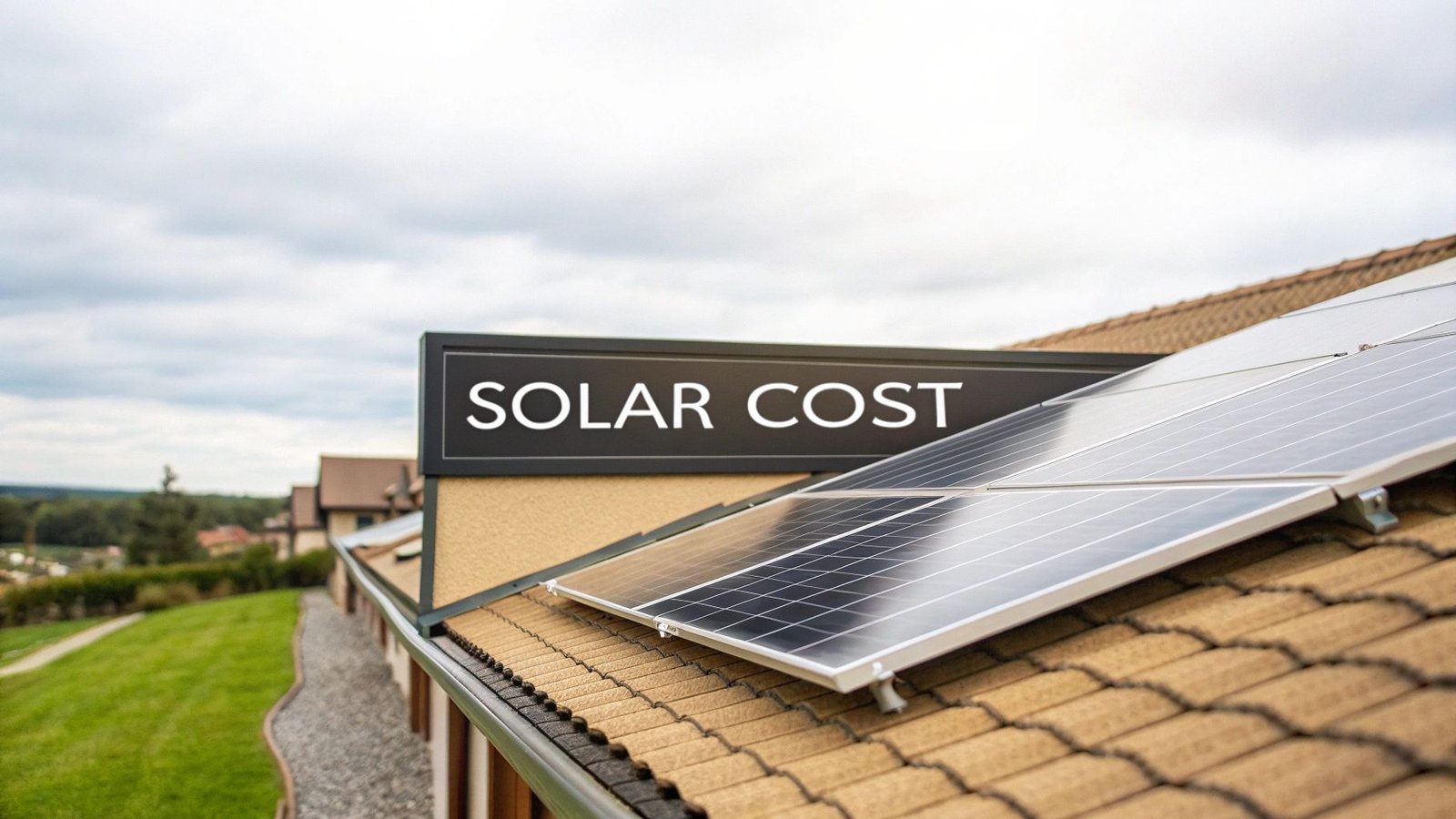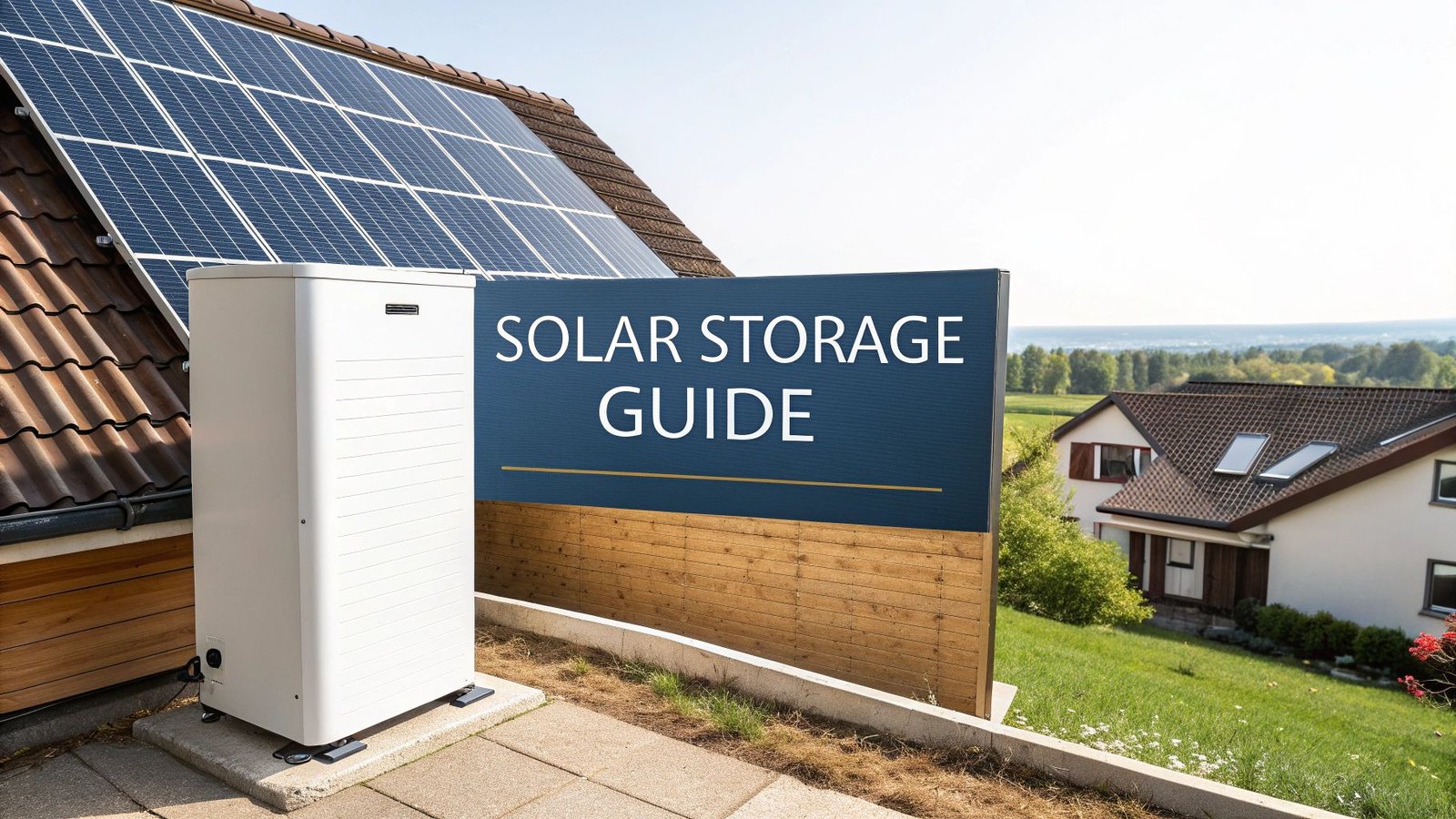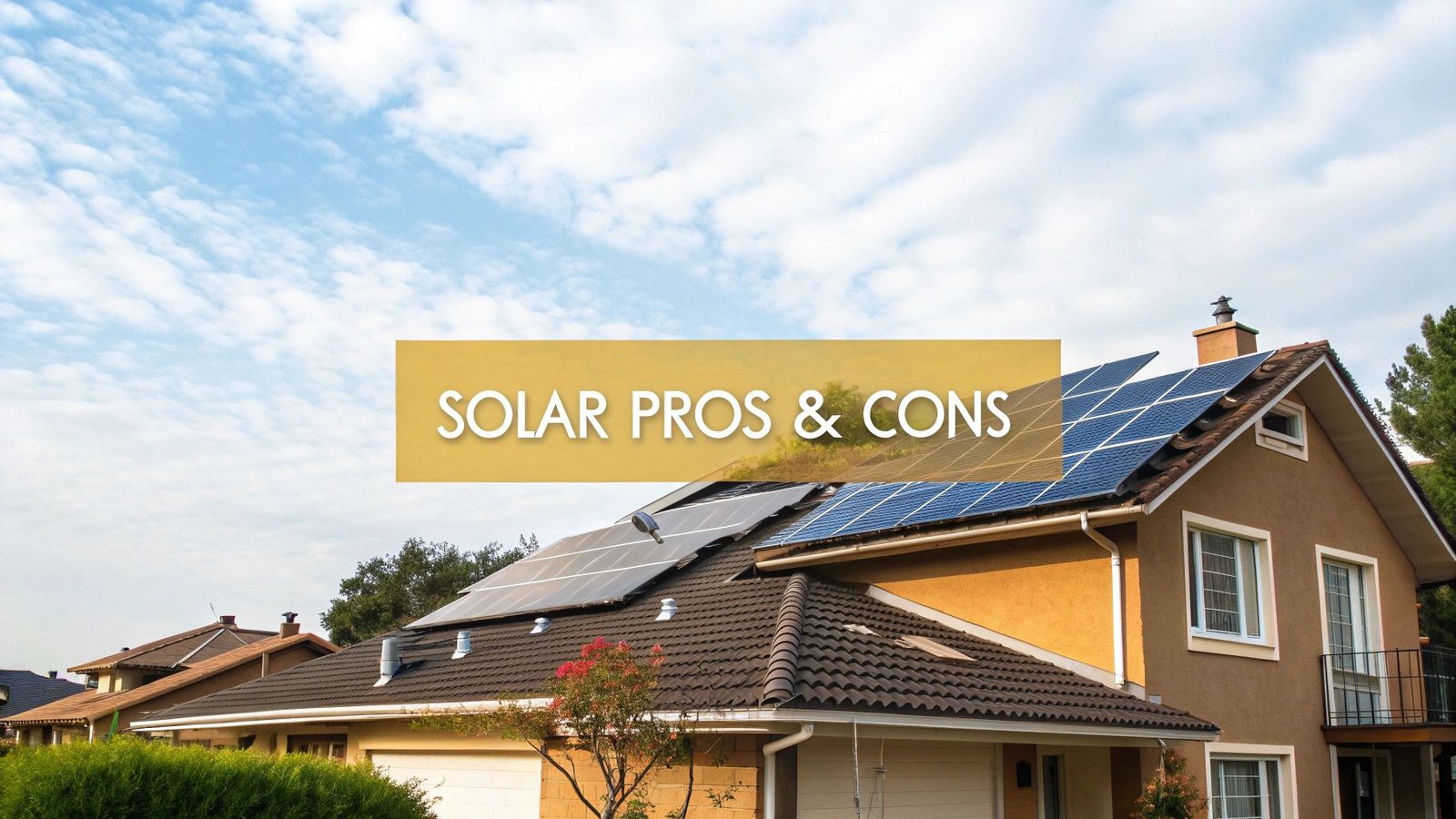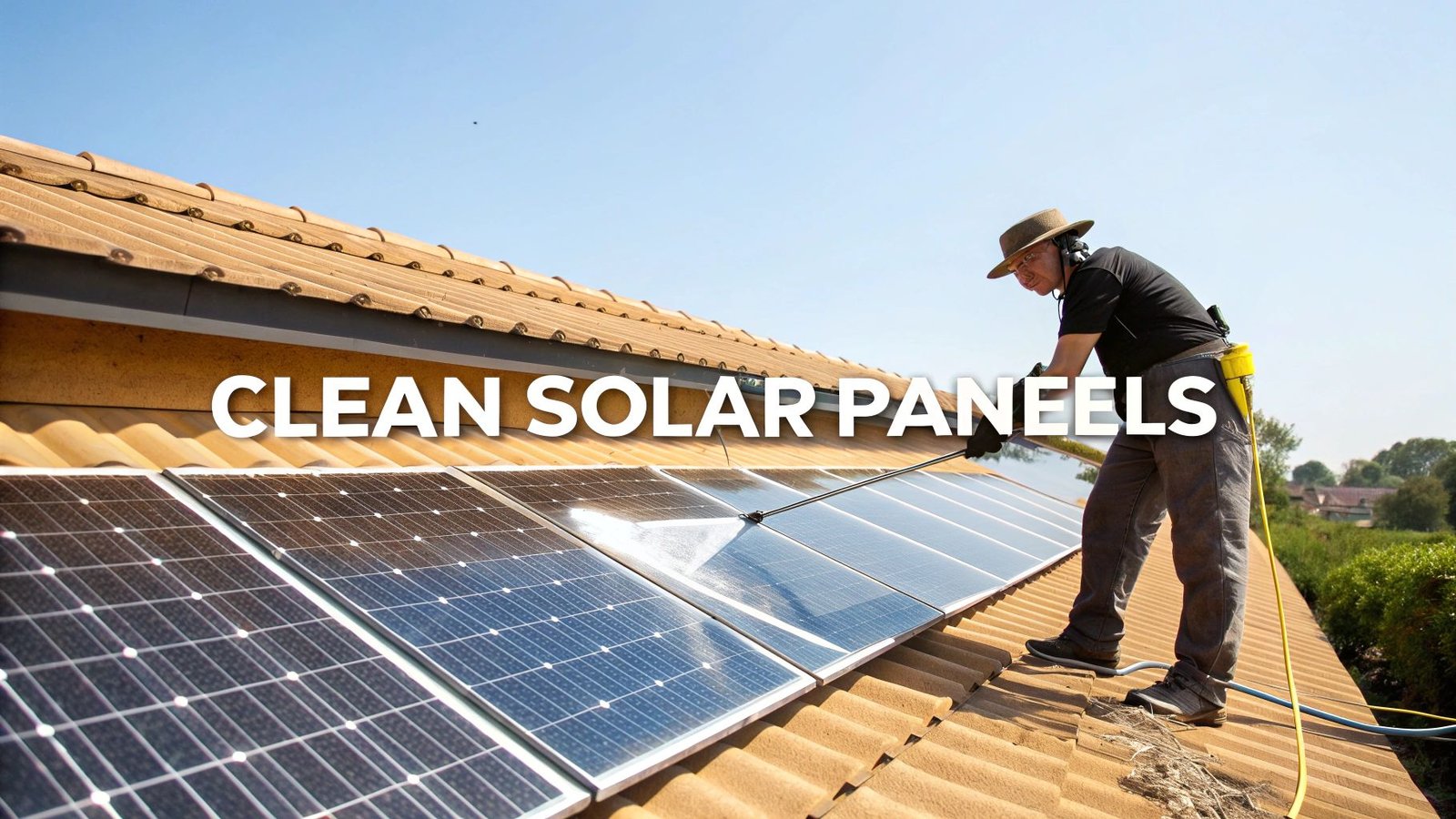Alright, let's get straight to the point. The question on everyone's mind is: how much does it actually cost to go solar?
For a typical home in the U.S., you're generally looking at an upfront investment between $15,000 and $25,000. That's before any tax credits or rebates kick in. To get a bit more technical, the industry usually prices systems on a cost-per-watt basis, which typically lands somewhere between $2.50 and $3.50.
So, What’s the Real Price Tag for a Home Solar System?
Trying to nail down the exact cost of a home solar system is a lot like buying a new car. You see the starting MSRP, but the final price depends entirely on the model, the features you add, and the dealership you work with. The national average is a great ballpark figure, but it’s just that—a ballpark.
The final number on your quote will be shaped by your family’s unique energy needs and the specifics of your home's roof and location.

The best news for anyone considering solar is that the technology has become dramatically more affordable over the last decade. Prices have plummeted globally, making solar accessible to more homeowners than ever before. This isn't just a U.S. trend; data from markets like the UK shows a steady decline, with the cost for larger residential systems dropping significantly between 2014 and 2023.
Estimated Home Solar System Cost by Size (Before Incentives)
To give you a clearer picture, it helps to look at costs based on the size of the system, which is measured in kilowatts (kW). A smaller home with modest electricity usage might only need a 5 kW system, whereas a larger home with an electric vehicle and central air might require a 10 kW system or even more.
The table and chart below give you a quick snapshot of what you might expect to pay for different system sizes. Remember, these are just estimates before applying any of the fantastic tax credits or local rebates that can bring the final cost down.
| System Size (kW) | Average Cost Per Watt | Estimated Total Cost |
|---|---|---|
| 5 kW | $3.00 | $15,000 |
| 8 kW | $2.90 | $23,200 |
| 10 kW | $2.80 | $28,000 |
As you can see, the cost per watt often decreases as the system size increases, offering better value for larger installations. Think of it like buying in bulk.
This provides a solid baseline for budgeting. For an even more detailed breakdown, you can explore our guide on how much do solar panels cost. Next, we’ll dig into exactly what factors—from the type of panels you choose to where you live—influence these prices.
What Really Drives Your Final Solar Panel Cost?
Knowing the national average for solar is a good benchmark, but it doesn't tell the whole story. The price you'll actually pay is far more personal. Think of it like buying a car—the sticker price is just the beginning. The engine you choose, the trim level, and any add-ons are what determine the final number on the contract.
Solar is the same way. Your final quote is a blend of several key ingredients. While you see one total, it’s really a breakdown of the specific equipment for your home, the labor needed to install it, and even factors unique to where you live.
This infographic lays out the main things that will shape your final cost.

As you can see, the type of panels you choose, the total size of your system, and the specific quirks of your roof are the big three that really drive the price.
System Size and Your Energy Needs
By far, the biggest single factor in your total cost is the size of the system you need, which we measure in kilowatts (kW). This isn't just a number pulled out of thin air; it’s directly tied to how much electricity your family uses over a year. A household with two electric cars and central air conditioning blasting all summer will obviously need a much bigger system than a smaller, more energy-conscious home.
More panels generate more power, but they also come with a higher upfront cost. The real art is in designing a system that’s a perfect match for your energy habits. You don't want to overpay for a massive system you'll never fully use, but you also don't want to undersize it and still be stuck with a high electric bill.
Panel Technology and Hardware
Let's be clear: not all solar panels are the same. The technology you pick directly impacts both the system's performance and its price tag.
- Monocrystalline Panels: These are the top-of-the-line option. You'll recognize them by their uniform black color. They're the most efficient, meaning they produce more electricity from a smaller space. This makes them perfect for homes with limited or partially shaded roofs, but they do cost more.
- Polycrystalline Panels: These are the workhorse panels, known for their distinctive blue, almost mosaic-like appearance. They're a bit less efficient than their monocrystalline cousins but are also friendlier on the wallet. If you have plenty of sunny roof space, they offer a great balance of cost and performance.
But it's not just about the panels. Other critical hardware adds to the total cost. This includes the inverter—the brains of the operation that converts DC power from the panels into the AC power your house can use—and the racking system that physically attaches everything securely to your roof.
Your Home's Installation Profile
Every single roof has its own personality, and these unique traits can affect the installation cost. A simple, south-facing roof made of asphalt shingles is the dream scenario for an installer—it's straightforward and the most affordable to work on.
Things get more complicated from there. A super steep roof, lots of gables and valleys, or delicate materials like slate or Spanish tile will require more time, specialized equipment, and skilled labor. Our detailed guide on solar panel system installation cost dives deeper into how your roof's specifics can move the needle on your budget.
The Big Picture on Costs: While the panels get all the attention, they are just one part of the equation. "Soft costs"—things like labor, pulling city permits, and scheduling inspections—can easily make up a huge chunk of your total investment.
Thankfully, the industry has seen incredible price drops over the years. This isn't just on the panels (photovoltaic modules) but also on all the other gear (balance of system). Between 1998 and 2011 alone, the average cost for a home solar system fell by $5.65 per watt. This massive drop was fueled by both cheaper hardware and smarter, faster installation methods.
How Geography Shapes Your Solar Investment

While it's helpful to know the national average, the average cost of solar panels can change dramatically the moment you cross state lines. It’s a lot like real estate—prices are hyper-local. Your specific address is one of the most significant factors driving both the upfront cost and the long-term value of a solar installation.
Imagine two identical homes, one in Arizona and the other in Massachusetts. They're going to get wildly different solar quotes. And it’s not just about the amount of sunshine they get. The final price tag is a complex mix of local labor costs, state regulations, and how competitive the solar market is in that area.
Why Location Matters for Solar Costs
A few key geographic factors have a direct impact on your project's bottom line. The biggest ones are almost always local labor rates and the headache-level of state and city permitting. It’s simple economics: states with a higher cost of living will have higher labor costs, and installers have to build that into their pricing.
On top of that, some towns have tangled permitting rules that demand extra paperwork, inspections, and time. These are often called "soft costs," and they can swing the final price by thousands, even between neighboring communities.
Key Takeaway: Relying solely on national data can set you up for sticker shock. Your state's unique market—including labor rates, supply chain access, and the number of installers vying for your business—is what really sets the price for solar where you live.
This regional pricing is just one piece of a much bigger global story. Over the last fifteen years, the average installed cost of solar PV worldwide has plummeted, landing around $758 per kilowatt by 2023. This incredible drop, thanks to better manufacturing and more accessible materials, has helped solar grow to about 5.5% of global electricity generation. You can explore more about these global solar cost trends and see the bigger picture.
Sunlight and Regional Price Differences
Of course, the amount of sun your roof actually sees—what the pros call solar irradiance—is a huge piece of the puzzle. A system in perpetually sunny Phoenix will pump out far more electricity over its lifetime than the exact same setup in often-cloudy Seattle.
What does that mean for your wallet? You might need a smaller, and therefore less expensive, system in a high-sunshine state to meet 100% of your energy needs.
The following table and chart break down how the cost per watt can vary across the country. They perfectly illustrate why getting quotes for your specific address is the only way to get a real sense of the cost.
Regional Snapshot of Average Solar Cost Per Watt
Here's a look at how the average cost per watt for a residential solar system can differ based on where you are in the United States. These variations come from local market conditions, labor costs, and the availability of regional incentives.
| US Region | Average Cost Per Watt (Range) |
|---|---|
| Southwest (e.g., AZ, CA) | $2.50 – $3.20 |
| Northeast (e.g., MA, NY) | $3.10 – $3.80 |
| Midwest (e.g., OH, IL) | $2.80 – $3.50 |
| Southeast (e.g., FL, GA) | $2.60 – $3.30 |
As you can see, there's no single "price" for solar. The combination of intense sun and a competitive market in the Southwest often leads to lower per-watt costs, while higher labor and business costs in the Northeast can push prices up.
Tapping into Solar Incentives and Tax Credits to Lower Your Costs

Here’s a secret that every seasoned solar installer knows: the initial price on a solar quote is almost never what you actually end up paying. Think of that number as a starting point, because the real story begins when you start subtracting the powerful financial incentives available to homeowners.
These programs, offered at the federal, state, and even local levels, can literally shave thousands of dollars off your final bill. Getting a handle on how they work is the key to seeing the true, and much more attractive, cost of going solar.
The Federal Solar Tax Credit: Your Biggest Discount
The single most important incentive for anyone considering solar is the federal Residential Clean Energy Credit. Don't mistake this for a simple deduction that just lowers your taxable income; this is a true, dollar-for-dollar credit that directly cuts down the federal income tax you owe.
For any system installed from 2022 onwards, you can claim a credit equal to 30% of the total system cost. This isn't just for the panels—it covers the inverter, any battery storage, and all the labor and installation costs, too.
So what does that look like in practice? Let's say your system has a total price tag of $25,000. The federal tax credit would give you $7,500 back ($25,000 x 30%). You then apply that $7,500 directly against what you owe the IRS. If your tax bill for the year is less than that, you can typically roll the remaining credit over to the next year.
Calculating Your Real Cost
This tax credit is the game-changer. It fundamentally alters the economics of a solar investment right from the start.
Let’s walk through how a typical project's cost gets whittled down:
| Cost Component | Example Amount |
|---|---|
| Gross System Cost | $25,000 |
| Less Federal Tax Credit (30%) | -$7,500 |
| Net Cost After Federal Credit | $17,500 |
| Less State & Local Incentives | -$2,500 (Varies widely) |
| Final Net System Cost | $15,000 |
As you can see, that $25,000 system quickly becomes a $15,000 system—or even less—once you layer on all the available incentives.
Don't Forget State and Local Perks
While the federal credit gets most of the attention, many states and local utilities sweeten the deal even more. These programs are all over the map, but they can stack up to create significant extra savings.
- State Tax Credits: A handful of states offer their own income tax credits, giving you a second opportunity to save.
- Utility Rebates: Your power company might offer a direct cash rebate, often based on the size of your system, just for installing solar.
- Performance-Based Incentives (PBIs): In some states, you can earn what are called Solar Renewable Energy Certificates (SRECs) for every bit of clean energy you produce. You can then sell these SRECs on a market, creating a small, ongoing income stream from your panels.
It's crucial to remember that to take advantage of these tax credits, you must own the system—either by paying cash or financing with a solar loan. Other arrangements might not qualify, which is a major point to consider when comparing solar leasing vs. power purchase agreements. As always, it’s a smart move to chat with a tax professional to be sure you understand how these credits will apply to your specific financial situation.
Figuring Out Your Solar Payback Period and ROI
A solar panel system isn't just another home upgrade; it’s a serious investment in your financial future. While everyone focuses on the initial price tag, the real story is about the long-term value. To really understand that, we need to look at two key numbers: your Return on Investment (ROI) and your payback period.
Here’s a simple way to think about it: going solar is like prepaying for your electricity for the next 25+ years, but at a huge discount. You’re effectively locking in your energy costs today, instead of being at the mercy of utility companies and their constantly rising rates. Just look at the numbers—utility costs have jumped over 20% between 2020 and 2023 alone.
How to Estimate Your Annual Savings
Want to get a ballpark idea of your savings? Start by grabbing your latest electricity bill. It holds the key information: how much power you use each month and what you're paying for each kilowatt-hour (kWh).
With that information, a solar installer can design a system perfectly sized to wipe out that bill. The basic math for figuring out your payback period is pretty simple:
Payback Period = (Net System Cost) / (Annual Electricity Savings)
Let's run a quick example. If your system costs $15,000 after all the tax credits and rebates, and you're saving $2,000 a year on electricity, your payback period is 7.5 years. After that, every bit of energy your panels produce is pure savings. You're getting free electricity for decades.
Visualizing Your Break-Even Point
Sometimes, a picture makes it all click. This chart shows how a typical solar investment plays out over time. You start with the upfront cost, but then the savings start stacking up year after year until you hit that break-even point.
As you can see, what begins as an expense quickly transforms into an asset. Once you cross that line, your system isn't just saving you money—it's making you money.
Solar as a Home Value Booster
The perks don’t just stop at your monthly bills. A solar installation is a proven way to increase your property's value, making it a tangible asset that pays off when you decide to sell.
Study after study confirms that homes with solar panels sell faster and for a higher price than similar homes without them. Potential buyers love the idea of lower, more predictable living costs, making it a huge selling point. It’s a lot like other smart home improvements; for instance, understanding your window replacement ROI is crucial for seeing the long-term financial upside. Both solar and new windows are smart moves that boost your home's efficiency and market appeal.
Common Questions About Solar Panel Costs
As you move from initial research to seriously considering a quote, the practical questions start to surface. It's one thing to know the average cost, but it's another to understand the real-world details that affect your budget and long-term planning. Let's tackle some of the most common questions homeowners ask on their solar journey.
Should I Get a New Roof Before Installing Solar Panels?
This is a big one, and getting it right can save you a massive headache and a lot of money down the road. Your solar panels are built to last 25 to 30 years, so you really want your roof to have the same kind of longevity.
If your roof is already pushing 15 years old or showing signs of wear and tear, replacing it before you install panels is almost always the smartest move. Imagine having to pay a crew to remove a full solar array just a few years in, replace the roof, and then reinstall everything. It’s a costly, avoidable hassle.
By tackling both projects at once, you streamline the labor and ensure your entire home energy system, from the shingles up, is good to go for decades.
Is It Better to Buy or Lease Solar Panels?
The "buy versus lease" debate really boils down to your main goal. Are you looking for maximum long-term financial return and true energy independence, or do you prefer a lower upfront cost to just start saving on your bills?
- Buying: When you buy your system—either with cash or a solar loan—you own the asset. This is the only path to claiming the lucrative 30% federal tax credit and any local incentives. It delivers by far the greatest savings over the life of the system.
- Leasing/PPA: With a lease or a Power Purchase Agreement (PPA), a third-party company owns the panels on your roof. You just pay them a fixed monthly fee for the electricity, which is usually less than what the utility company charges. It's a great low-barrier option, but you miss out on the tax credits, and your long-term savings will be much more modest.
The graph below really shows the financial story over time. Buying has that initial cost but eventually leads to total energy freedom once the system is paid off. Leasing offers smaller, predictable savings from day one without the ownership benefits.
What Ongoing Maintenance Costs Should I Expect?
One of the best things about modern solar panels is how little maintenance they need. They're built to withstand the elements with no moving parts. For most homeowners, ongoing costs are close to zero.
In many places, a good rainstorm is all the cleaning your panels will ever need. If you live in a particularly dry or dusty region, you might budget for a professional cleaning every year or two, which typically runs between $150 and $300.
The main component you'll want to plan for is the inverter, which is the brain of the system. Inverters usually come with a warranty of 10 to 15 years. Factoring in one potential inverter replacement over the 25- to 30-year life of your system is just smart financial planning.
Ready to see what a solar investment looks like for your specific home? The expert team at Radiant Energy can provide a free, no-obligation quote tailored to your energy needs and budget. We'll walk you through every option and incentive to maximize your savings. Get Your Free Solar Quote Today




